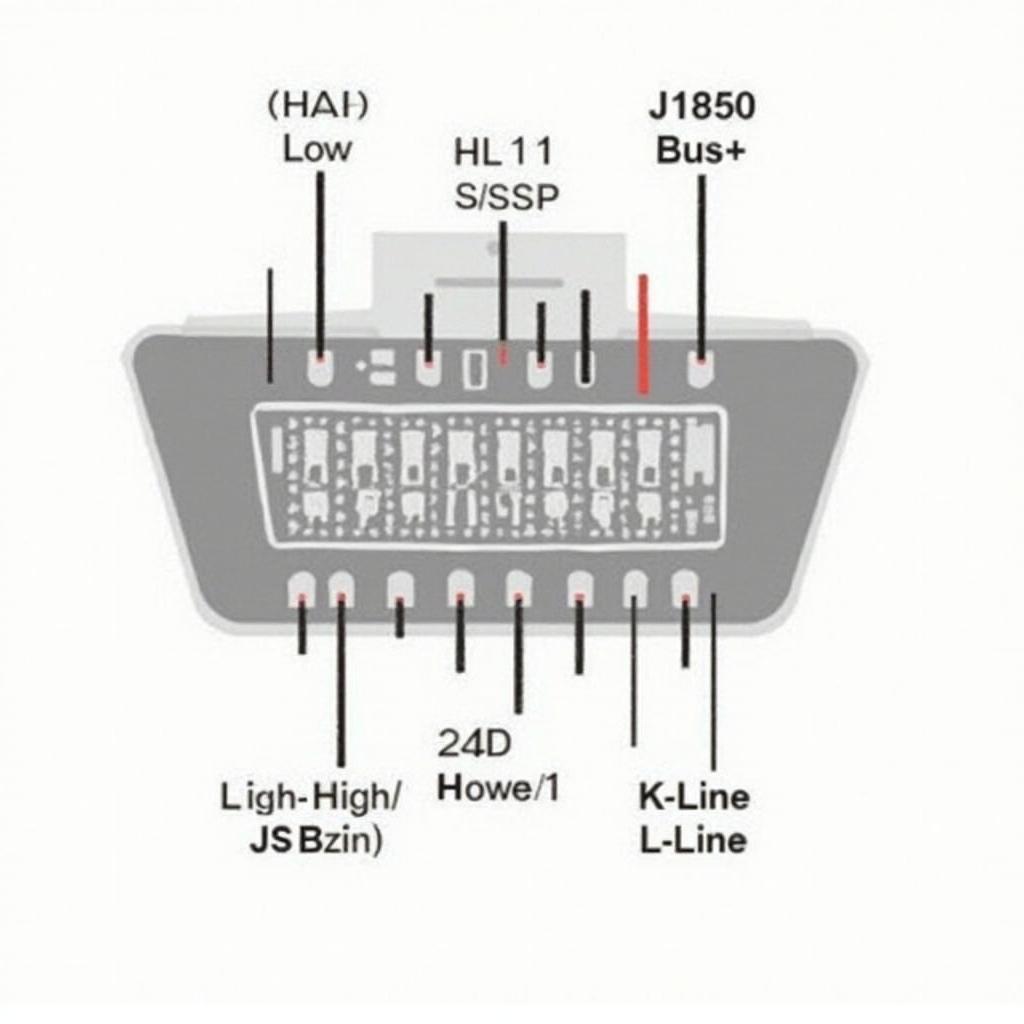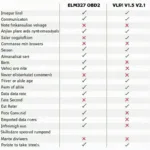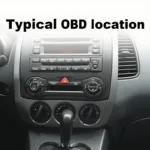The OBD2 pin list, often a source of confusion for car owners, is actually a standardized layout that unlocks a wealth of information about your vehicle’s health. Understanding this layout is crucial for effective diagnostics and maintenance. This guide will demystify the OBD2 port and its pin assignments, equipping you with the knowledge to interpret and leverage its diagnostic power.
Understanding the OBD2 Port and its Significance
The OBD2 port, officially known as the On-Board Diagnostics II port, is a standardized 16-pin connector found in most vehicles manufactured after 1996. It serves as the gateway to your car’s computer systems, enabling communication with diagnostic tools like OBD2 scanners. These scanners retrieve diagnostic trouble codes (DTCs), monitor real-time data, and perform various tests, giving you valuable insights into your vehicle’s performance. Do you know if your Ford Mondeo is OBD2 compliant? Check out our guide on is ford mondeo obd2 compliant.
What Does Each OBD2 Pin Do?
Each pin on the OBD2 connector has a specific function, ranging from power supply to communication lines. Here’s a detailed breakdown of the standard OBD2 pin list:
- Pin 1: Manufacturer Discretionary, or in some cases, for Chrysler’s CCD Bus (Chrysler Collision Detection) network.
- Pin 2: J1850 Bus+ (used by some Ford vehicles)
- Pin 3: Manufacturer Discretionary
- Pin 4: Chassis Ground
- Pin 5: Signal Ground
- Pin 6: CAN High (Controller Area Network)
- Pin 7: K-Line (ISO 9141-2 and ISO 14230-4 protocols)
- Pin 8: Manufacturer Discretionary
- Pin 9: Manufacturer Discretionary
- Pin 10: J1850 Bus- (used by some GM vehicles)
- Pin 11: Manufacturer Discretionary
- Pin 12: Manufacturer Discretionary
- Pin 13: Manufacturer Discretionary
- Pin 14: CAN Low (Controller Area Network)
- Pin 15: L-Line (ISO 9141-2 and ISO 14230-4 protocols)
- Pin 16: Battery Power
Why is Knowing the OBD2 Pin List Important?
Understanding the obd2 pin list is valuable for several reasons. It allows you to troubleshoot connectivity issues, choose the right OBD2 scanner for your vehicle, and even understand the communication protocols used by your car’s systems. Have you explored the world of HUD displays? Learn more about hud head up display with obd2.
Common OBD2 Pinout Configurations
While the pinout is standardized, the use of specific pins can vary between vehicle manufacturers and communication protocols. For instance, some manufacturers may utilize discretionary pins for specific functions unique to their vehicles. Here’s a simplified look at the communication protocols and their associated pins:
- SAE J1850 PWM (Pulse Width Modulation): Primarily used by Ford vehicles, this protocol utilizes pins 2 (Bus+) and 10 (Bus-).
- SAE J1850 VPW (Variable Pulse Width): Primarily used by GM vehicles, this protocol also uses pins 2 (Bus+) and 10 (Bus-).
- ISO 9141-2: Commonly used in European and Asian vehicles, this protocol utilizes pins 7 (K-Line) and 15 (L-Line).
- ISO 14230-4 (KWP2000): Also found in European and Asian vehicles, this protocol utilizes pins 7 (K-Line) and 15 (L-Line).
- CAN (Controller Area Network): The most modern protocol, CAN uses pins 6 (CAN High) and 14 (CAN Low), and is widely adopted across most vehicle manufacturers. Have you tried Torque Pro? Find out more about this powerful Android OBD2 scanner at torque pro android obd2 scanner.
“Understanding the nuances of the OBD2 pin list empowers car owners to take control of their vehicle’s diagnostics. It’s like having a direct line to your car’s brain,” says automotive expert, Dr. Emily Carter, Ph.D. in Automotive Engineering.
Troubleshooting OBD2 Port Issues
Sometimes, you might encounter issues with your OBD2 port. A common problem is a lack of power. This can often be traced back to a blown fuse. Always consult your vehicle’s owner’s manual to identify the correct fuse for your OBD2 port. Ever wondered about OBD2 catalytic converter readiness? Our guide on obd2 catalytic converter not ready has the answers.
“Regular checks of your OBD2 port can prevent future diagnostic headaches. It’s a simple yet crucial step in maintaining your vehicle’s health,” adds Dr. Carter. “For professional-grade diagnostics, understanding how the nissan consult software work with obd2 scanner can be invaluable.”
In conclusion, understanding the obd2 pin list is fundamental to effective vehicle diagnostics. This knowledge empowers you to make informed decisions about maintenance and repairs, ultimately saving you time and money.
FAQ
- What is the purpose of the OBD2 port?
- How do I find the OBD2 port in my car?
- Are all OBD2 scanners compatible with all vehicles?
- What is a Diagnostic Trouble Code (DTC)?
- Can I use the OBD2 port for anything other than diagnostics?
- What are the different communication protocols used by OBD2?
- What should I do if my OBD2 port is not working?
Need further assistance? Contact us via WhatsApp: +1(641)206-8880, Email: [email protected] or visit our office at 789 Elm Street, San Francisco, CA 94102, USA. Our 24/7 customer support team is always ready to help.


